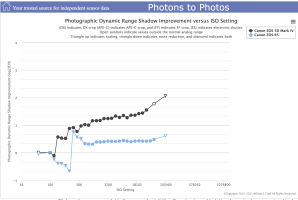"1 stop better". That is a wow claim.I shot the R3 in low light yesterday evening and found that it's about a stop better than the R5. I'm not talking about per-pixel apples and oranges, but versus the R5 downsampled to 24 megapixels. It still shot about a stop better. I don't know if it's from the sensor or also partly from some extra noise cooking going on, but whatever they're doing, it's working pretty well.
The 24 megapixel aspect is, surprisingly, not much of an issue for anything that isn't reach-limited. It really does shoot above its megapixel weight. The comment from some days ago that it's about the sharpness/detail equivalent of the 5D4's 30 MP is probably exactly right. But at this point - despite loving the R3 - I don't plan on keeping it because the things I shoot typically *are* reach-limited, so the R5 is going to be better for me.
My average published shot is perhaps 35 percent of the frame, and typically winds up 300 dpi. To give perspective, with the R3, if you shot in landscape orientation something you wanted to be on the cover of a magazine, you'd be able to crop only 1/8th of the height of the image before you sank below 300 pixels per inch. And, yes, you can get good cover shots with 4 megapixels, yada yada, but if you brought a 4 megapixel sensor to this knife fight, you'd get gunned down most times by someone else. I had the same decision back when I had the A9 Mark II (24mp) and the A7r Mark IV (61MP). I found eventually that I kept using the A7r4 whenever I went to shoot wildlife, even though it was really the remit of the A9; and it was just for the resolution. Been there before. But I do recognize my use case isn't normal.
As an aside, I see a lot of people assuming the R1 will be a higher resolution sensor, but that actually doesn't conform to any Canon precedent. I expect the R1 will be a really cool camera with a sensor that will - as it has for the last decade, without fail - disappoint those wishing for resolution similar to that found in competing cameras. I'm hoping, instead, that we'll see an R5 Mark II in two years (yes, it'll be that long) that adopts much of the R3 tech and even more resolution.
Upvote
0

